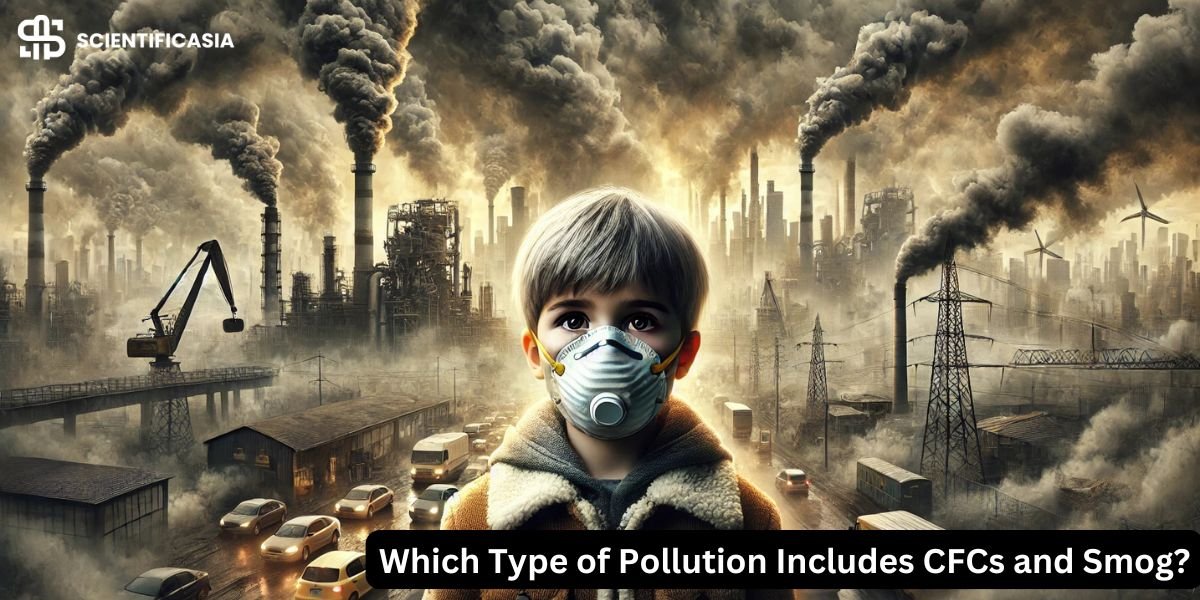Introduction
Pollution is a growing environmental issue that threatens ecosystems, human health, and the planet’s climate. Among its many forms, air pollution is particularly harmful, as it directly affects the quality of the air we breathe. If you’re wondering, which type of pollution includes CFCs and smog? The answer is air pollution.
From the hazy skies over bustling cities to the invisible yet dangerous presence of chemicals, air pollution poses significant risks. Two major contributors are chlorofluorocarbons (CFCs) and smog—both of which impact air quality in different ways. CFCs are synthetic chemicals that deplete the ozone layer, while smog is a dense, ground-level pollution that endangers respiratory health. Understanding their distinct roles and interconnected effects is essential in tackling their harmful consequences.
This article explores how CFCs and smog contribute to air pollution, their environmental and health impacts, and the steps we can take to mitigate them.
Defining Air Pollution: The Big Picture
Air pollution is the contamination of the atmosphere by harmful substances, including gases, particulate matter, biological molecules, and other pollutants. These substances can be natural, such as volcanic ash, or human-made, resulting from industrial processes, transportation, and other activities. Air pollution can be categorized in various ways, including indoor versus outdoor pollution and primary versus secondary pollutants. This article will primarily focus on outdoor air pollution, specifically examining the roles of CFCs and smog.
Types of Pollution
Pollution can be classified into various categories, including:
- Air Pollution (the primary focus of this article)
- Water Pollution (contamination of rivers, lakes, and oceans)
- Soil Pollution (degradation of land due to chemicals and waste)
- Noise Pollution (excessive noise affecting health and well-being)
Why Air Pollution?
Air pollution refers to the presence of harmful substances in the Earth’s atmosphere. It can result from both natural sources (like volcanic eruptions) and human activities (such as industrial emissions and vehicle exhaust). CFCs and smog are major components of air pollution, contributing to severe environmental and health hazards.
What Are CFCs?
Definition and Sources
Chlorofluorocarbons (CFCs) are synthetic compounds composed of carbon, chlorine, and fluorine. They were widely used in:
- Refrigeration and air conditioning systems
- Aerosol propellants
- Foam-blowing agents
- Industrial solvents
These chemicals were once considered safe and efficient but later proved to have catastrophic effects on the ozone layer.
How CFCs affect to Air Pollution
- CFCs are released into the atmosphere from products like aerosol sprays and refrigerants.
- Once in the atmosphere, they rise into the stratosphere, where they are broken down by ultraviolet (UV) radiation.
- This breakdown releases chlorine atoms, which deplete the ozone layer—a protective shield that blocks harmful UV rays.
Fact: The Montreal Protocol, an international treaty signed in 1987, successfully phased out most CFC production, significantly reducing ozone depletion. (Source: United Nations Environment Programme – UNEP)
What Is Smog?
Definition and Types
Smog is a type of severe air pollution that forms when pollutants react with sunlight. There are two main types:
- Photochemical Smog – Formed by the reaction of sunlight with pollutants like nitrogen oxides and volatile organic compounds (VOCs). This is common in cities with heavy traffic.
- Industrial Smog – Formed by burning coal and fossil fuels, releasing sulfur dioxide and particulate matter.
How Smog Affects Air Quality
- Reduces visibility, affecting transportation and daily life
- Causes respiratory illnesses such as asthma, bronchitis, and lung infections
- Damages crops and ecosystems due to toxic compounds
- Contributes to climate change by trapping heat in the atmosphere
Example: Los Angeles, California, is infamous for its photochemical smog due to its high levels of vehicle emissions and sunny climate.
The Link Between CFCs and Smog
While CFCs do not directly cause smog, they contribute to air pollution in several ways:
- Ozone Layer Depletion: CFCs break down ozone molecules, leading to higher levels of UV radiation, which can worsen smog formation.
- Greenhouse Effect: CFCs are potent greenhouse gases, contributing to global warming and altering weather patterns that can influence smog levels.
Impact of CFCs on the Ozone Layer
How CFCs Deplete the Ozone
- CFC molecules reach the stratosphere and break down under UV radiation.
- Released chlorine atoms destroy ozone (O₃) molecules, thinning the protective layer.
- A weakened ozone layer increases UV exposure, leading to higher skin cancer rates, cataracts, and environmental damage.
Fact: A single chlorine atom from a CFC molecule can destroy 100,000 ozone molecules. (Source: NASA Ozone Watch)
Which Factors Can Trap Pollutants and Cause Dangerous Smog?
Temperature Inversion
Normally, warm air rises and carries pollutants away, but during a temperature inversion, warm air gets trapped above a layer of cold air, holding contaminants close to the ground.
Real-World Examples of Smog Events
- The Great Smog of London (1952): Caused by coal burning, killing an estimated 12,000 people.
- Delhi Smog Crisis (2017): Air pollution levels reached 999 AQI (Air Quality Index), far beyond safe limits.
(Sources: Environmental Protection Agency – EPA, World Health Organization – WHO).
Why Is Air Pollution Dangerous?
Air pollution is dangerous because it affects every aspect of our lives. From causing life-threatening diseases to accelerating climate change, the impact of pollutants like CFCs and smog is far-reaching. Addressing air pollution is not just an environmental issue but a public health imperative.
Health and Environmental Impacts
Smog poses significant risks to human health. Exposure to smog can trigger respiratory problems such as asthma, bronchitis, and other lung diseases. It can also exacerbate cardiovascular issues and cause eye irritation. (Source: World Health Organization – Air pollution: https://www.who.int/news-room/fact-sheets/detail/air-pollution)
The environmental impacts of smog include damage to plants and ecosystems, reduced visibility, and, in some cases, a contribution to climate change.
Ozone depletion caused by CFCs leads to increased UV radiation, which, as mentioned earlier, increases the risk of skin cancer, cataracts, and immune system suppression.
Prevention and Mitigation of CFCs and Smog
Global Efforts
- Montreal Protocol (1987): Phased out CFCs globally.
- Clean Air Act (U.S.): Reduced emissions from industries and vehicles.
- EU Air Quality Directives: Set air pollution limits across Europe.
Individual Actions
- Use eco-friendly refrigerators and air conditioners.
- Reduce car usage; opt for public transport, cycling, or walking.
- Support clean energy sources (solar, wind, hydropower).
Conclusion: A Breath of Fresh Air
Air pollution, driven by CFCs and smog, poses serious risks to human health and the environment. While global efforts have reduced CFC emissions, smog remains a persistent challenge in urban areas. By adopting sustainable practices, enforcing strong regulations, and raising public awareness, we can minimize the impact of these pollutants and ensure cleaner air for future generations.
Let’s take action today for a healthier tomorrow! 🌍
(Sources: NASA, WHO, EPA, UNEP, Norwegian Ministry of Climate and Environment)
FAQs
1. What are the main causes of smog?
Smog is primarily caused by emissions from vehicles, industries, and burning fossil fuels. It forms when pollutants react with sunlight.
2. How does smog affect human health?
Smog can cause respiratory diseases, eye irritation, and long-term lung damage. Prolonged exposure can lead to heart problems and reduced lung function.
3. Why were CFCs banned?
CFCs were banned because they deplete the ozone layer, leading to increased UV radiation exposure, which causes skin cancer and environmental harm.
4. Can smog be completely eliminated?
While smog cannot be entirely eliminated, its impact can be reduced through stricter regulations, clean energy adoption, and individual actions like using public transport.
5. How can individuals help reduce smog?
People can reduce smog by using energy-efficient appliances, reducing car emissions, supporting green policies, and planting trees to improve air quality.














